ARM A53/A57/T760 investigated - Samsung Galaxy Note 4 Exynos Review
by Andrei Frumusanu & Ryan Smith on February 10, 2015 7:30 AM ESTCPU and System Performance
While we've gone over some hefty material till now, we're still missing a crucial comparison for the Note 4 with Exynos 5433. How does it fare against the Snapdragon 805 version?
For this comparison we go to check one last time the estimated SPECint2000 score of the two devices. Again, this benchmark is purely for an architectural comparison between Qualcomm's Krait cores and ARM's new A57 CPUs. This is an outdated and deprecated benchmark and isn't really representative of mobile workloads, but it gives a good idea of synthetic CPU performance.
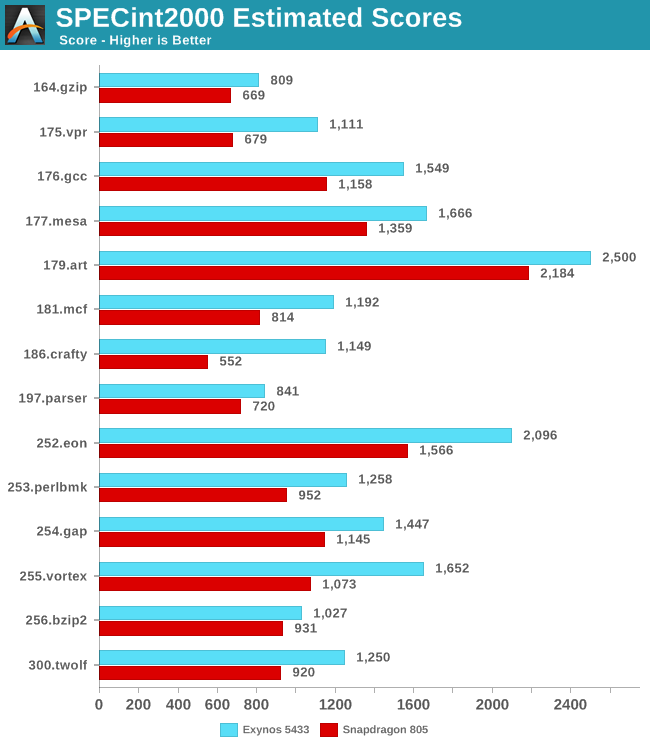
Qualcomm's Krait core is by now almost three years old - a long time since we first saw the first Snapdragon S4 phones come out. Qualcomm has been able to squeeze a lot of life out of the architecture with the help of incremental updates, but now it's clearly reaching its limits. At 2.7GHz the device is still at an estimated 37% overall disadvantage against the 1.9GHz clocked A57 in the Exynos 5433 variant.
The Snapdragon 810 is just around the corner and we'll be seeing Qualcomm adopt ARM's new ARMv8 cores instead of relying on their own design. Qualcomm is certainly working on their own custom ARMv8 core, but there's still not much in the way of details other than to expect it around roughly a year from now. As it stands, the first half of 2015 seems to be dominated by A57 SoCs.
We continue on to our more classic set of browser JavaScript based benchmarks. This time around I'm including the stock browser scores alongside Chrome to demonstrate an issue I'll be getting to in just a bit...
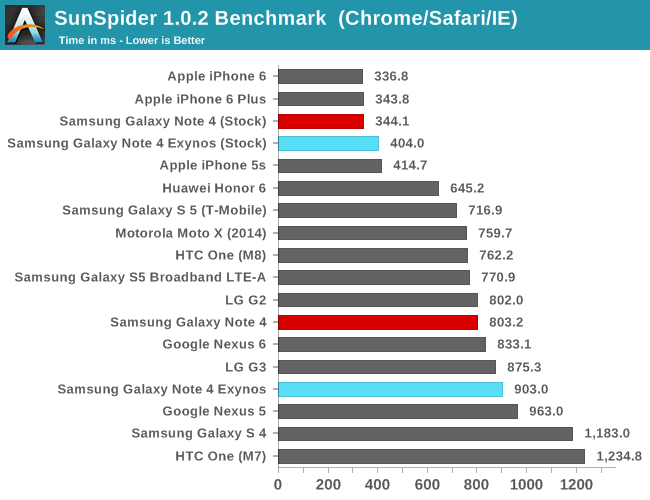
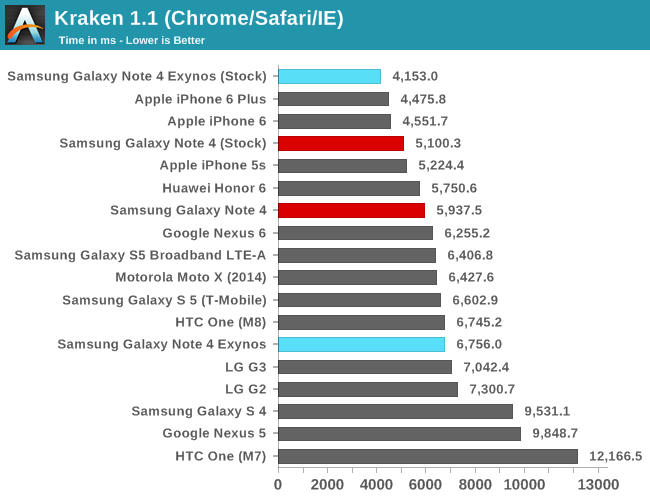
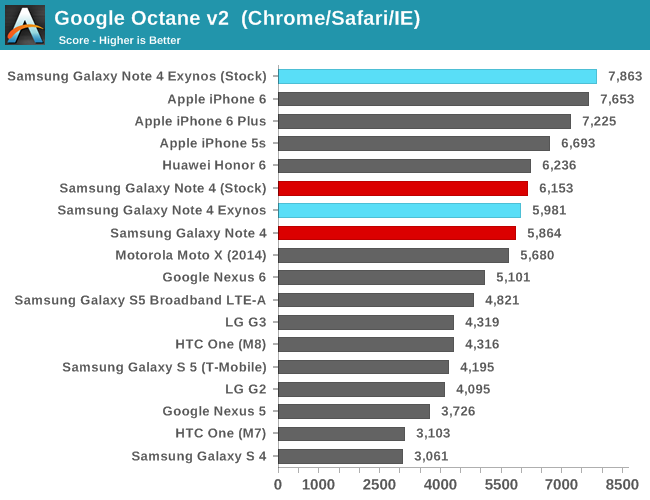
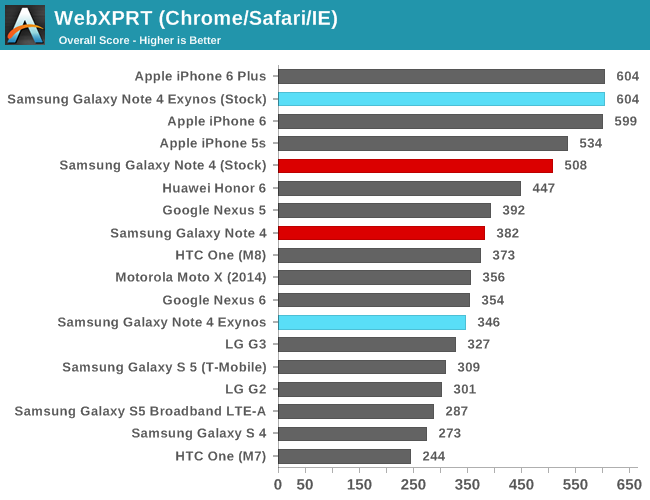
What we're seeing here is an increasing problem of our browser benchmarks. Vendors have optimized their stock browser libraries to target the specific CPU and GPU of a given device to be able to squeeze all possible performance out of the hardware. This aspect grows increasingly important as the architectures start to vary quite a lot between each other. Here employing Chrome as-is by Google is a great disadvantage as it's not optimized for any one platform. Google offers partial solutions (e.g. the Chrome Samsung Support Library which enables Chrome to use some stock OS browser libraries - a definite improvement in speed over vanilla Chrome), but it hasn't seen an update in over eight months and doesn't work on the Exynos 5433.
With significant performance improvements of the ARMv8 cores of the Exynos 5433 needing at least an AArch32 compiled code-base for them to be unleashed, it's natural to try to stick to Samsung's own solutions until the Android ecosystem gets updated. Curiously, the Snapdragon 805 also benefits from the stock browser, meaning Samsung is also extensively optimizing for that platform.
The scores on the Exynos version of the Note 4 are outstanding, beating out all existing devices in our more complex benchmarks. SunSpider is the exception, but seeing the vast discrepancy between browsers and even the Snapdragon version matching Apple's new A8 has made us come to the conclusion that this benchmark has run it's time as a valid test case, and thus we're dropping it from our 2015 test suite going forward.
Heading over to BaseMark OS II as our more general system benchmark, we see again the Exynos version outperform the Snapdragon. It's not quite enough to beat Apple's A8 processor in the new iPhones, still lagging a bit behind their custom architecture and OS.
We'd like to mention that there has been a big overhaul in BaseMark OS II in a recent December release, fixing various issues regarding score computation, and it also introduced changes in the benchmarks themselves. As such, the new scores are not directly comparable to reviews published in the past. We've re-run the most recent flagship devices through the new benchmark and will go forward with the new version for future articles. The new scores are now labeled "BaseMark OS II 2.0" instead of "BaseMark OS II".
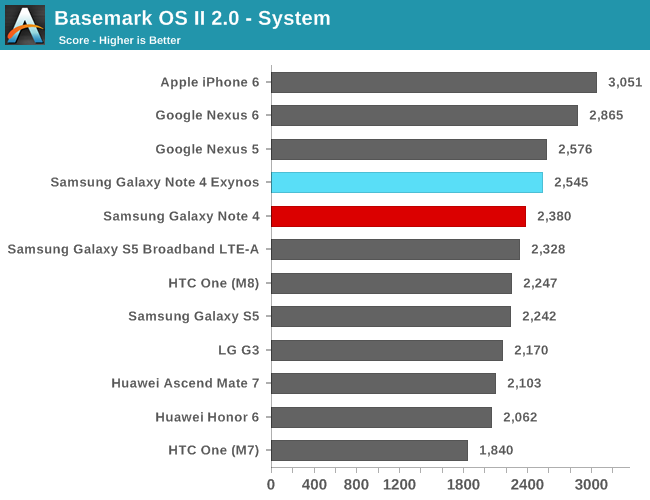
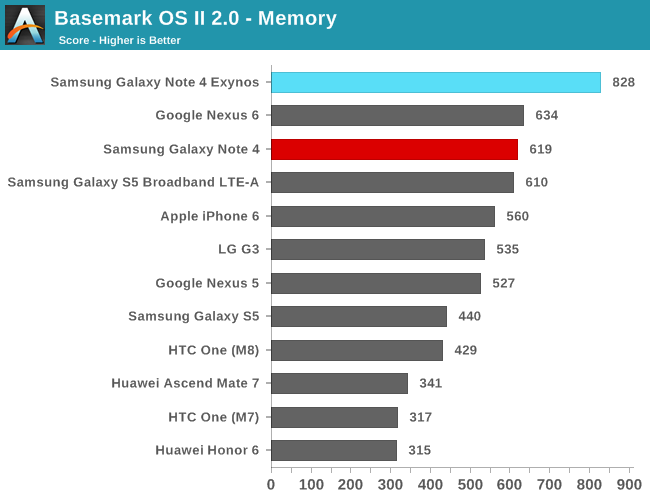
The memory test is a general NAND speed test. Here the Exynos version is outperforming the Snapdragon by quite a bit. This is intriguing as one would expect both versions to employ the same eMMC, but that's not the case. This Exynos version uses an R21AMA eMMC chip while our tested Snapdragon unit has an R218MA chip. They're both 32GB units, so I'm not too sure if there's a performance delta between what appears to be different series of this eMMC model or if this can be attributed to Samsung's use of a more performant Synopsys DesignWare MMC controller in the Exynos compared to Qualcomm's own SDCC. I double checked this in our AndroBench test and there there was no significant deviation from the Snapdragon review unit, so this might just be a peculiarity of the specific load of the memory test in BaseMark OS II that favors the Exynos eMMC controller and SoC architecture.
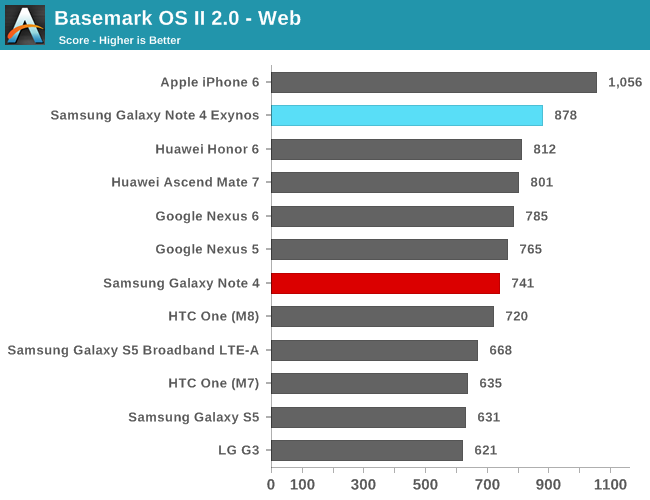
The web test is dependent on resolution as it's rendering an HTML canvas elements and doing CSS transformations on-screen. The Exynos Note 4 leads all other Android devices, only again coming short of the iPhone 6 - but one must keep in mind this test is resolution dependent and the iPhone's lower resolution for sure helps.
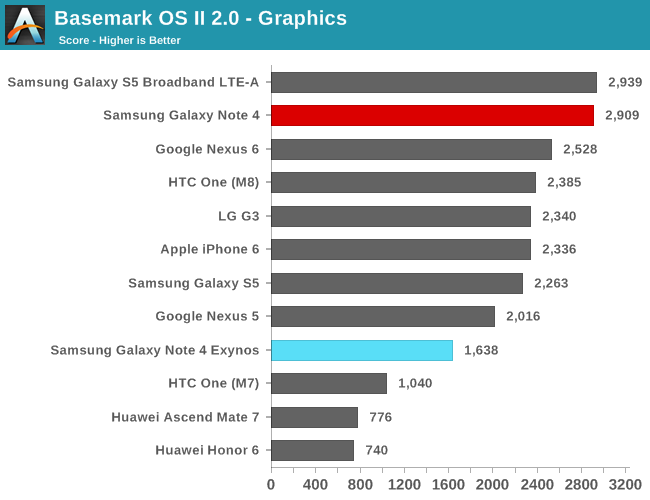
The graphics test again is dominated by the Snapdragon version of the Note 4. The Adreno 420's vast ALU and fillrate throughput are clearly visible as it manages to separate itself from the competition. The Mali T760, while still leading the ARM pack, is well behind Qualcomm's and Imagination's GPUs.
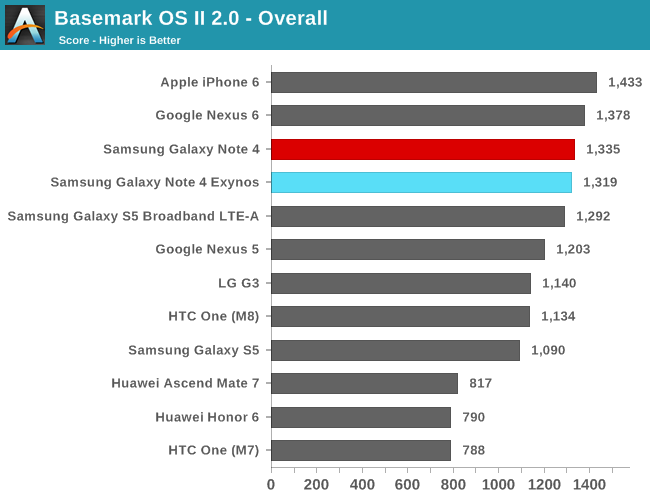
Due to the underwhelming graphics score, it brings down the overall result of BaseMark OS a bit beneath that of the Snapdragon version of the Note 4.
As part of our 2015 test suite we're introducing Futuremark's PCMark for Android into our mobile device reviews. PCMark is an overall system workload that uses Android's built-in libraries and APIs, a very common use-case that we find in a lot of Android applications.
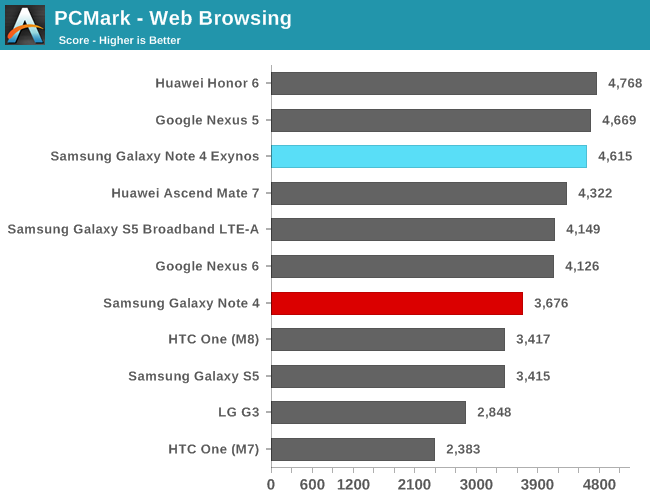
The web browsing test on PCMark uses a native Android WebView to display and interact with the web pages. It tests performance by measuring time to render pages, search for content (JavaScript performance), and time to re-render the page as images are altered.
Here we see the Exynos version again outperforming the Qualcomm Note 4 by a substantial amount. It's also interesting to see the Nexus 5 and Honor 6 that high up on the test, definitely a sign of how this is a system test rather than just a purely synthetic CPU performance test.
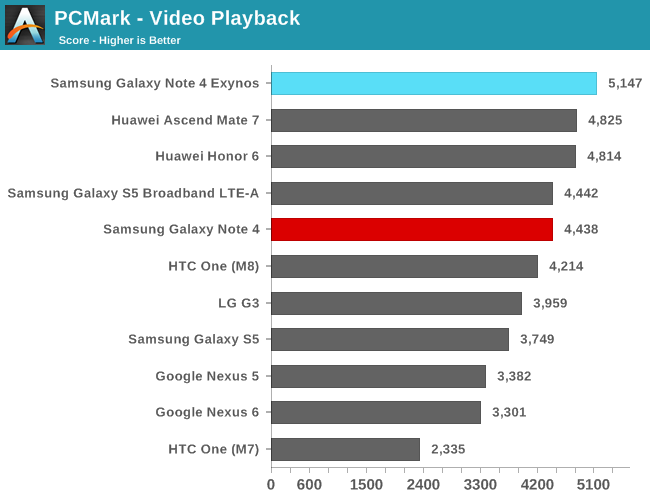
The video playback test uses the native Android MediaPlayer API to play back a 1080p H.264 baseline 4.0 video, with a variable target bit rate of 4.5Mbps at 30 FPS. What is measured here is the time needed to open the video samples, their average frame rates, and the seek time when skipping through the videos.
The Exynos is again at the top, outperforming all other benchmarked devices. Beyond testing the OS and API performance, this is also a test stressing the hardware as it tests the eMMC speed and the hardware decoder of the devices. We're seeing top notch performance from Samsung's device here as the video loads and seeks virtually instantly. I've seen excellent performance from Exynos hardware decoders ever since the Galaxy S2 and the Exynos 4210, which back in the day (as opposed to the competition) had no issues with even heavy 50Mbps streams. It seems Samsung is continuing that trend to this day.
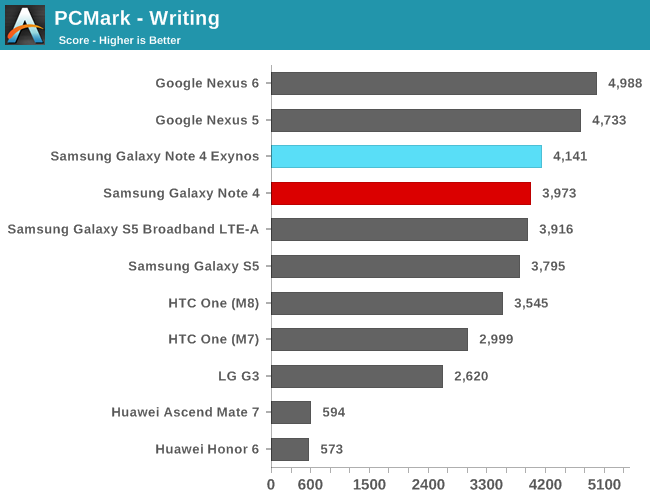
The writing test measures performance when manipulating a native EditText view. It loads, decompresses, and pastes two documents together into a large 200k character piece of text. This is then compressed into a ZIP and saved. Further text manipulation is done and the API overhead and performance is measured.
The Exynos has a slight edge over the Qualcomm Note 4, but they're both beat out by the Android 5.0 Lollipop Nexus 5 and 6 devices. I'm happy to see a test being able to measure general UI and API performance on Android as it's an aspect of device performance that was rarely touched upon.
As a side note, I've seen abysmal performance on my Huawei devices for this test. It seems there is some issue in EmotionUI that leads the Mate 7 and Honor 6 to lag behind by a considerable amount in this benchmark.
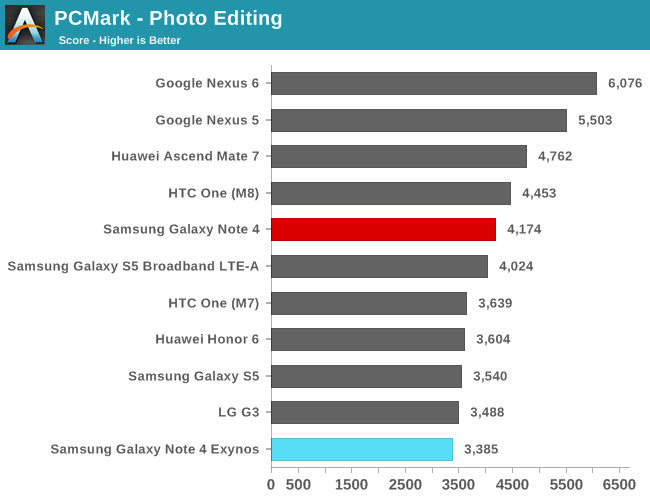
The photo editing test is a mix between API performance and both GPU and CPU performance. Image effects are applied via both the native effect API in Android as well as a RenderScript that tests heterogeneous processor performance (GPU and CPU). Additionally a Java library is used to test Java performance through processing filters that are computed on the CPU.
We see the Exynos performing last in this test-case, while our Lollipop devices lead the pack. It seems this is an issue with the OS libraries as the Mate 7, which also employs a Mali GPU, performs quite well in this test, pointing out that it's not a hardware performance limitation.
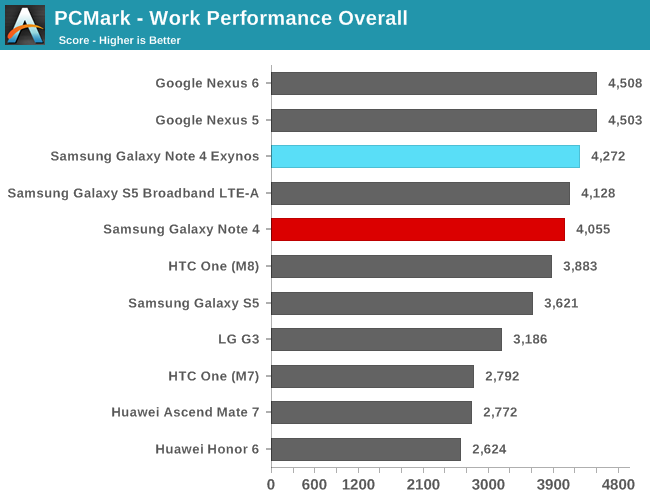
The overall work performance score for the Exynos Note 4 falls slightly ahead of the Qualcomm version. It will be interesting to see how the battlefield changes as more devices get updated to Lollipop; there's evidently a large performance boost to be expected as portrayed by our Nexus 5/6 numbers.
Overall, the Exynos's CPU is much ahead of the Snapdragon. This is not only seen in benchmarks but also real-world usage as the device is snappier and more fluid. Some people might notice microstutters on the Snapdragon version; Qualcomm is still relying on CPU hot-plugging for their power management. Hot-plugging is a Linux kernel operation that takes a CPU out of coherency and is a slow and expensive operation that forces the device to stop for a certain time. This overhead has been vastly reduced over the years as things were optimized in the Linux kernel, but it is still very much an unfavorable mechanic nowadays. Modern ARM Cortex CPUs now use their power collapse states via the CPUIdle framework, which avoids such issues.
Next let's inspect the graphics performance of the Exynos Note 4.










135 Comments
View All Comments
MrSpadge - Tuesday, February 10, 2015 - link
Excellent work, guys! But let me point out something:1. Your Geekbench numbers show spectacular gains for the A53. They're actually so good that the multi-threading speed-up almost always exceeds the number of cores (judging by eye, have not run the numbers). For A7 the speedup factor is a bit less than 4, right where it should be. It certainly looks like the big cores were kicking in, at least partly.
2. You wonder that power scales sub-linearly with more cores being used. Actually this is just what one would expect in the case of non-ideal multi-thread scaling (as the A7 shows in Geekbench). The load of all ccores may be the same, percentage-wise, but when running many threads these are competing for L2 cache and memory bandwidth. There will be additional wait times under full load (otherwise the memory subsystem is vastly oversized), so each core is busy but working a little less hard.
3. The lower performance per W of the A53: this may well be true. But if the big cores did interfere, it could certainly explain the significantly increased power draw.
4. You hope for A53 at 1.5 - 1.7 GHz. I agree for CPUs which use only A53's. But as little cores this is not necessary. If you push a design to higher frequencies at the same technology node you always pay in terms of power efficiency (unless you start bad / unoptimized). Better let the little cores do what they're best at: be efficient.
... I'm off to the next page :)
MrS
Andrei Frumusanu - Tuesday, February 10, 2015 - link
Regarding your concerns on the big cores turning on: They did not. I made sure that they're always offline in the little testing. As to why GeekBench scaled like that, I can't answer.jjj - Tuesday, February 10, 2015 - link
Geekbanch scales like that sometimes, TR looked at this phone last week and they notice the Shield tab scaling better than 4x in some tests.For the A53 better scaling over A7 maybe it's the memory subsystem? No clue how heavy GB is on it but the A53 does have more memory BW and maybe faster NAND (you don't have storage tests for the Alpha ).
MrSpadge - Tuesday, February 10, 2015 - link
Sometimes one gets such results if the MT code path uses newer libraries to get multi threading, but also introduce other optimizations the tester is not aware of. Or they have to rewrite code/algorithm to make it multi-threaded and thereby create a more efficient version "by accident". I don't know if any of this applies to GB, though.tipoo - Tuesday, February 10, 2015 - link
It's done that before, I think the cache is almost certainly involved. Maybe it has good cache reusability for multicore in its testing.SydneyBlue120d - Tuesday, February 10, 2015 - link
Excellent article, thanks a lot for that.I'd like to dig deeper about why Samsung is ruining the wonderful Wolfson DAC, I remember that even the legendary François Simond shared the issue with Samsung Developers without getting a response, maybe You will be able to have a response :) Also, I remember an audio quality test suite, why didn't You use it in this review? Thanks a lot.
Andrei Frumusanu - Tuesday, February 10, 2015 - link
We realized testing audio without having the proper equipment is a futile exercise and does not really portray audio quality of a device. Only Chris has the professional equipment to objectively test audio, such as done in the iPhone6 review: http://www.anandtech.com/show/8554/the-iphone-6-re...PC Perv - Tuesday, February 10, 2015 - link
Thank you so much for ditching SunSpider, and thank you for explaining why. It has gone way too long.PC Perv - Tuesday, February 10, 2015 - link
I know you are trying to be nice to your colleague and give them a benefit of doubt, but to mercilessly critical eyes of mine your colleagues (Joshua Ho & Brandon Chester) have shown and time and time again they are not qualified to review Android products. I hope Mr. Frumusanu and Mr. Smith will take charge of this area in the future and limit those two to Apple product reviews.I would love to read quality reviews and analysis like this instead of their tamper tantrum.
PC Perv - Tuesday, February 10, 2015 - link
For example, in the comment section here,http://www.anandtech.com/comments/8795/understandi...
[Q]The increase in brightness for AMOLEDs at 80% APL rather than 100% APL is not very significant, and changing testing to accommodate AMOLED's idiosyncrasies doesn't seem like a good idea either. To put it in perspective, even if I had tested the Nexus 6 at 80% APL in the review my conclusion about the brightness being sub-par would have been exactly the same.[/Q]
That is what Brandon Chest had to say about brightness of the Nexus 6's screen. So arrogant, so biased. But according to the scientific data provided by this article (pg. 10), APL can indeed make a huge difference in AMOLED screen's brightness, given power target. For example, at display power target is 1W, 70% APL will raise the brightness by approximately 40%. At 50% APL, max brightness practically doubles.
I was appalled by the disparaging and arrogant attitude by Brandon Chester when it comes to correctly evaluating Android devices. He also made similarly nonsensical "arguments" in his tablet recommendation article for the holidays.